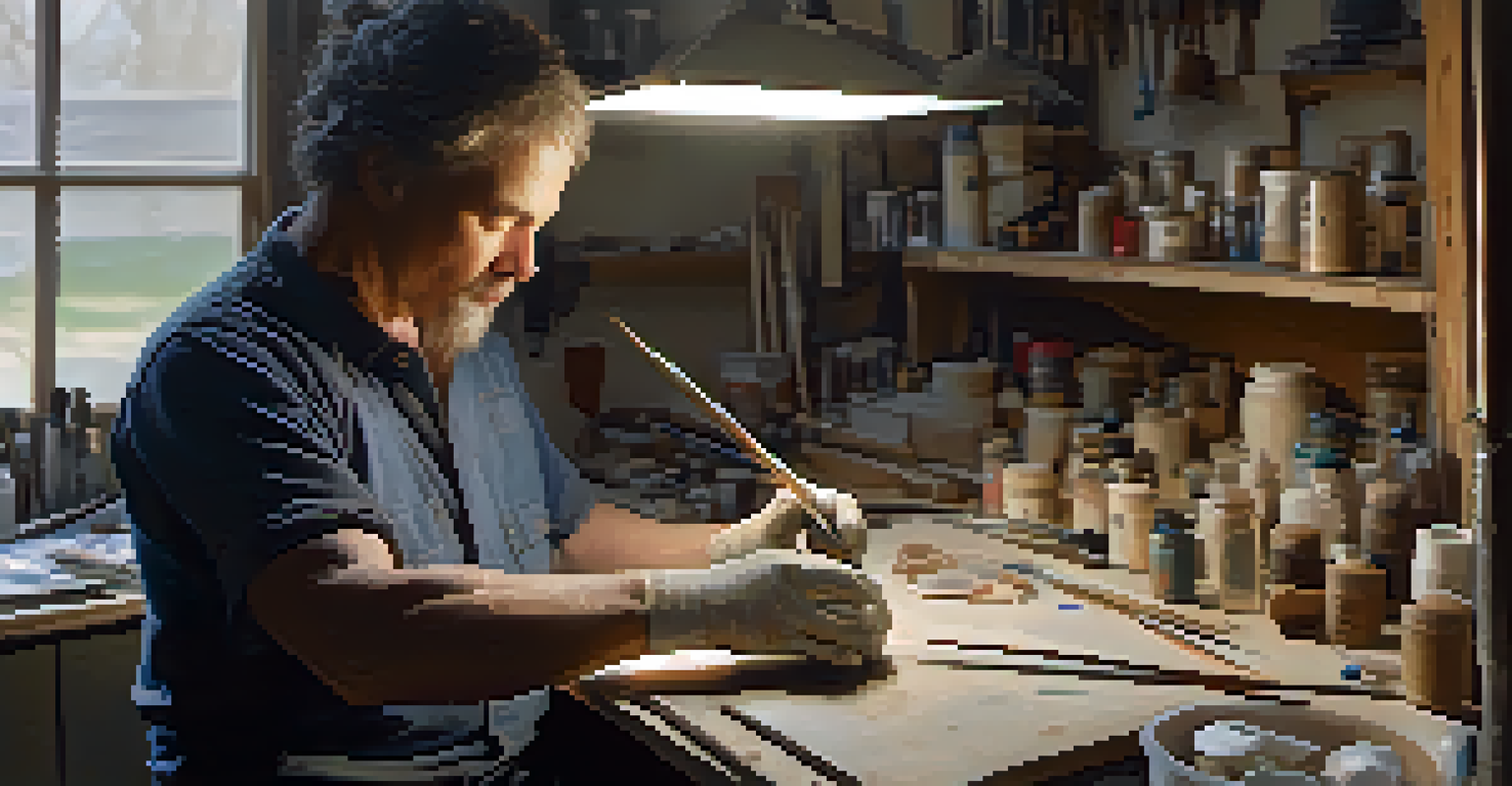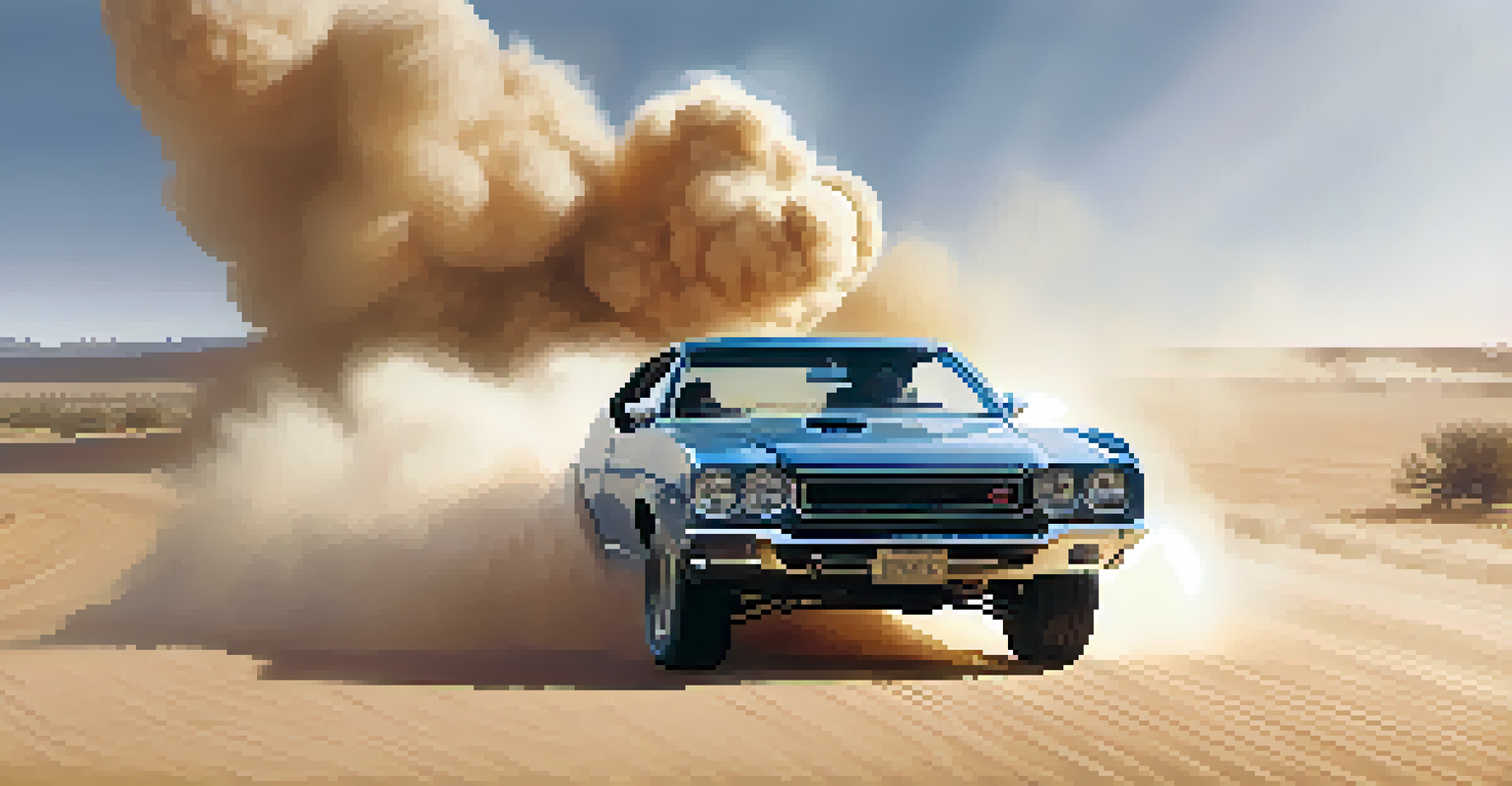Creating Realism: The Use of Practical Effects in Filmmaking

Understanding Practical Effects and Their Importance
Practical effects refer to physical effects that are created on set, rather than relying solely on digital effects. These tangible elements can include miniatures, animatronics, and pyrotechnics, bringing a sense of authenticity to the film. While CGI has its place, practical effects often create a more visceral connection with the audience, as they can see real materials interacting in real-time.
Practical effects create a visual reality that CGI simply cannot replicate, engaging the audience on a visceral level.
The significance of practical effects lies in their ability to ground fantastical elements in reality. For instance, the use of physical models in 'Star Wars' allowed viewers to suspend disbelief, making spaceships feel real and relatable. This tangible quality can evoke genuine emotions, enhancing the viewer's immersive experience.
Moreover, practical effects often lead to more dynamic performances from actors, who can react to real-world stimuli instead of imagining their surroundings. This interaction creates a richer storytelling environment, where both the actors and the audience can engage more deeply with the narrative.
A Brief History of Practical Effects in Film
The use of practical effects dates back to the early days of cinema, with films like 'A Trip to the Moon' using innovative techniques to create visual magic. As technology evolved, filmmakers experimented with various methods, from stop-motion animation to elaborate puppetry, to draw audiences into their stories. Each era brought new possibilities, allowing creativity to flourish.

Iconic films of the 1980s, such as 'The Thing' and 'Ghostbusters', showcased the power of practical effects, utilizing makeup and animatronics to create unforgettable creatures. These films not only left a lasting impression but also set a standard for the industry, proving that practical effects could create compelling visual narratives.
Practical Effects Enhance Authenticity
By using real elements on set, filmmakers create a tangible experience that resonates more deeply with audiences.
Today, many filmmakers still embrace practical effects, often blending them with CGI for a balanced approach. This hybrid method leverages the strengths of both types, ensuring that the final product maintains a level of realism that resonates with audiences.
The Role of Practical Effects in Modern Filmmaking
In today’s filmmaking landscape, practical effects continue to play a vital role, even amid the rise of digital technology. Filmmakers like Christopher Nolan and Guillermo del Toro prioritize practical effects, believing they enhance the overall authenticity of the film. Their commitment to using real elements helps to create a tangible world that audiences can believe in.
The best visual effects are the ones you don't notice, and often, those are the practical ones that blend seamlessly into the story.
For example, in 'Inception', the stunning rotating hallway scene was achieved using a real set, allowing actors to perform in a dynamic environment. This choice not only added realism but also made the scene more visually striking. When audiences see real objects and actors interacting, they are more likely to be engaged and immersed in the story.
Moreover, practical effects can often be more cost-effective than extensive CGI, especially for independent filmmakers. By investing in practical techniques, filmmakers can achieve high-quality results that resonate with viewers, proving that creativity often triumphs over budget.
How Practical Effects Enhance Audience Engagement
One of the most compelling reasons to utilize practical effects is their impact on audience engagement. When viewers see real explosions, intricate makeup, or lifelike puppetry, it fosters a sense of wonder and excitement. This tangible connection can evoke emotional responses that resonate long after the credits roll.
Consider the heart-pounding chase scenes in 'Mad Max: Fury Road', where real stunts and vehicles were used to create breathtaking sequences. The adrenaline rush from witnessing real action, rather than computer-generated imagery, draws viewers deeper into the film’s world. This level of engagement is difficult to achieve with CGI alone.
Historical Significance of Practical Effects
From early cinema to iconic 1980s films, practical effects have continually shaped the visual storytelling landscape.
Additionally, practical effects often encourage discussions among fans and critics alike, as they appreciate the craftsmanship involved. The artistry behind these effects can elevate a film's status, making it memorable and sparking a legacy that continues to inspire future filmmakers.
The Art and Science of Creating Practical Effects
Creating practical effects is a blend of artistry and scientific understanding, requiring a unique set of skills. From sculpting and painting to engineering and pyrotechnics, the process involves collaboration among various specialists. This teamwork ensures that every element works harmoniously to achieve the desired visual impact on screen.
For instance, the creation of lifelike prosthetics involves meticulous attention to detail, ensuring that the skin tone, texture, and movement are as realistic as possible. This precision is key to making characters believable, especially in genres like horror, where the uncanny can evoke strong reactions from the audience.
Moreover, advancements in technology, such as 3D printing, have revolutionized the way practical effects are created. Filmmakers can now produce intricate designs more efficiently, allowing for greater creativity and experimentation. This evolution keeps practical effects relevant and exciting in an ever-changing industry.
Challenges and Limitations of Practical Effects
Despite their many advantages, practical effects come with challenges and limitations. For one, they often require more time and resources to create than digital alternatives. Filmmakers must carefully plan and execute each effect, which can lead to longer production schedules and potential budget constraints.
Additionally, some practical effects may not always yield the desired results on camera. Factors like lighting, camera angles, and movement can significantly affect how an effect appears in the final cut. This unpredictability can lead to frustrations during post-production, forcing filmmakers to adapt their vision.
Future of Practical Effects Looks Bright
As filmmakers blend practical techniques with digital technology, the demand for authentic experiences is likely to drive a resurgence in practical effects.
However, many filmmakers embrace these challenges, viewing them as opportunities for creativity. By finding innovative solutions and thinking outside the box, they can produce remarkable effects that enhance the storytelling experience, ultimately overcoming the limitations that practical effects may present.
The Future of Practical Effects in Filmmaking
Looking ahead, the future of practical effects in filmmaking appears promising. As audiences increasingly crave authenticity and immersive experiences, practical effects may see a resurgence in popularity. Filmmakers are likely to continue combining practical elements with cutting-edge digital technology to create visually stunning narratives.
Moreover, the rise of independent filmmaking has made it easier for creators to experiment with practical effects. With access to online resources and communities, aspiring filmmakers can learn techniques and share their innovation, fostering a new generation of artists passionate about practical effects.

Ultimately, the enduring appeal of practical effects lies in their ability to connect with audiences on a deeper level. As filmmakers continue to push creative boundaries, we can expect to see a harmonious blend of tradition and innovation that keeps the magic of practical effects alive in cinema.